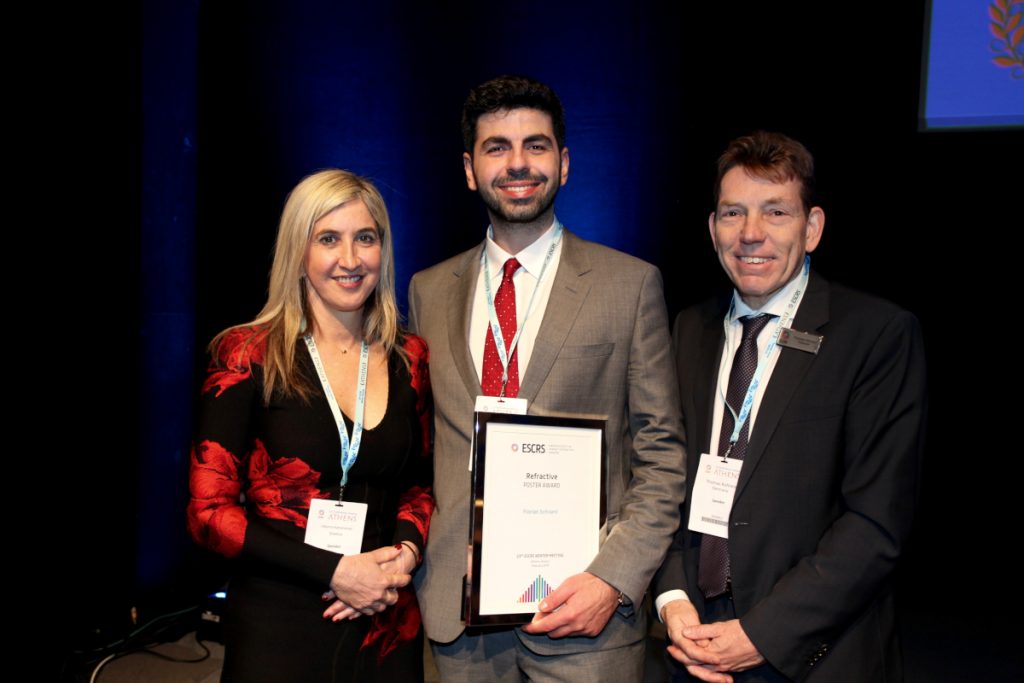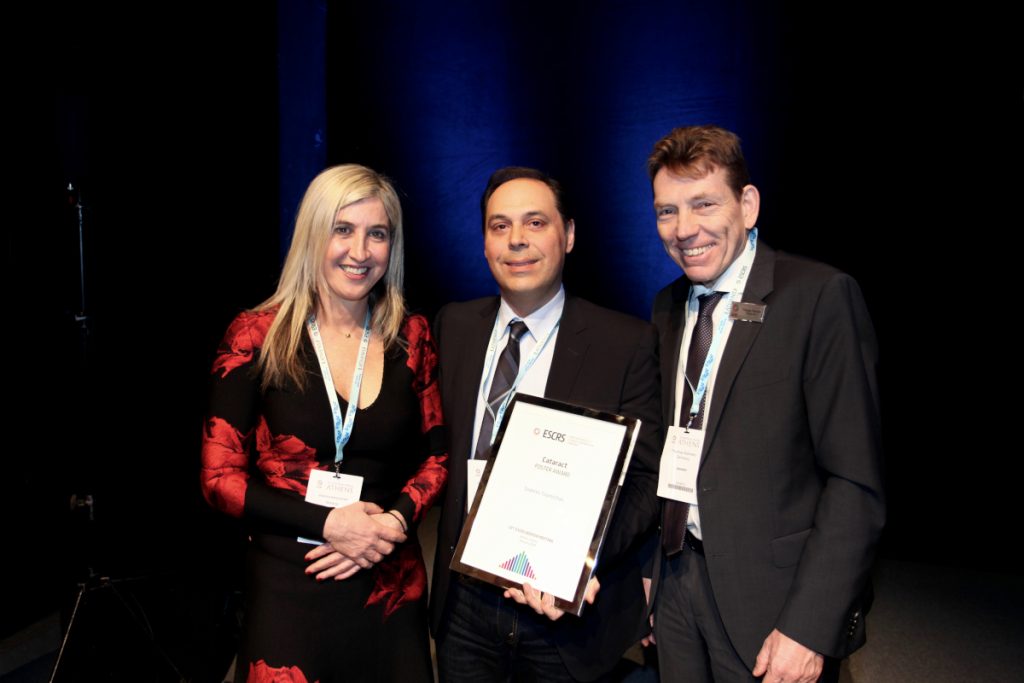23rd ESCRS Winter Meeting poster winners
Poster prizes provide new insights in secondary cataract and refractive procedures

Roibeard O’hEineachain
Published: Saturday, February 16, 2019
 Apostolos Lazaridis, on behalf of Florian Schraml, accepting the award for Best Refractive Poster from Vikentia Katsanevaki and Thomas Kohnen[/caption]
Studies on intraocular lens power calculation and scleral IOL fixation won the poster awards at the 23rd ESCRS Winter Meeting in Athens, Greece.
The prize in the Refractive category went to Florian Schraml, Germany, for “Predictability of intraocular lens power calculation after SMILE for myopia”. The poster describes a study that included 204 eyes of 105 patients, who underwent IOL implantation following small incision lenticule extraction (SMILE ®), procedures. All eyes underwent preoperative evaluation with the IOLMaster® 500 (Carl Zeiss Meditec) and corneal tomography using Pentacam HR (Oculus). Repeat measurements at three months postoperative showed that the ray-tracing outperformed third- and fourth-generation IOL formulas in terms of refractive predictability. The next-best performing IOL calculation formulas were the Haigis-L, in which the difference was only +0.244±0.83 D, and the Preußner formula, in which the difference was only -1 1.272 D.
[caption id="attachment_14058" align="alignleft" width="1024"]
Apostolos Lazaridis, on behalf of Florian Schraml, accepting the award for Best Refractive Poster from Vikentia Katsanevaki and Thomas Kohnen[/caption]
Studies on intraocular lens power calculation and scleral IOL fixation won the poster awards at the 23rd ESCRS Winter Meeting in Athens, Greece.
The prize in the Refractive category went to Florian Schraml, Germany, for “Predictability of intraocular lens power calculation after SMILE for myopia”. The poster describes a study that included 204 eyes of 105 patients, who underwent IOL implantation following small incision lenticule extraction (SMILE ®), procedures. All eyes underwent preoperative evaluation with the IOLMaster® 500 (Carl Zeiss Meditec) and corneal tomography using Pentacam HR (Oculus). Repeat measurements at three months postoperative showed that the ray-tracing outperformed third- and fourth-generation IOL formulas in terms of refractive predictability. The next-best performing IOL calculation formulas were the Haigis-L, in which the difference was only +0.244±0.83 D, and the Preußner formula, in which the difference was only -1 1.272 D.
[caption id="attachment_14058" align="alignleft" width="1024"] Ioannis Tzamichas accepting the award for Best Cataract Poster from Vikentia Katsanevaki and Thomas Kohnen[/caption]
The prize in the cataract category went to Ioannis Tzamichas, Greece, for “Scleral fixation of dislocated 1-piece IOL without IOL explantation or intrascleral sutureless 3-piece IOL fixation: making the right surgical decision”. The poster describes a retrospective consecutive case series of 22 patients who underwent scleral IOL fixation following complicated cataract surgery. It showed that among seven aphakic patients, mean visual acuity improved from hand movements to 0.8 and among 17 pseudophakes it improved from 0.05 to 0.63. There were no major ocular complications in either group.
Ioannis Tzamichas accepting the award for Best Cataract Poster from Vikentia Katsanevaki and Thomas Kohnen[/caption]
The prize in the cataract category went to Ioannis Tzamichas, Greece, for “Scleral fixation of dislocated 1-piece IOL without IOL explantation or intrascleral sutureless 3-piece IOL fixation: making the right surgical decision”. The poster describes a retrospective consecutive case series of 22 patients who underwent scleral IOL fixation following complicated cataract surgery. It showed that among seven aphakic patients, mean visual acuity improved from hand movements to 0.8 and among 17 pseudophakes it improved from 0.05 to 0.63. There were no major ocular complications in either group.